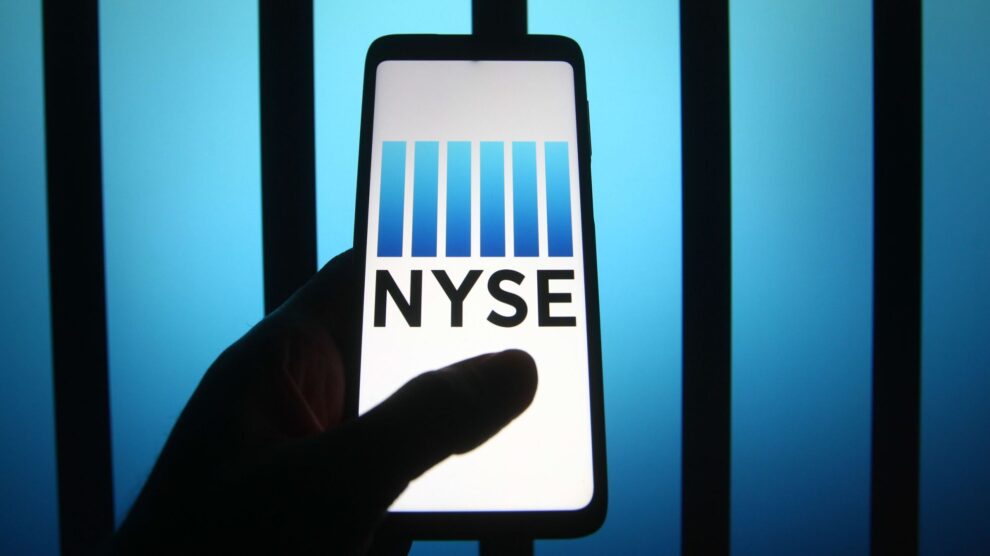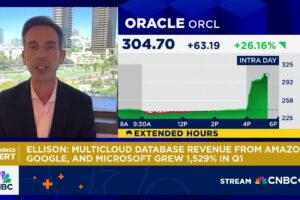
All three major indices closed in the green on Tuesday with the big tech names leading the way to a small. Frances Newton Stacy, Optimal Capital Director of Strategy, and Sarah House, Wells Fargo Senior Economist join Yahoo Finance’s Adam Shapiro and Seana Smith discuss the latest.
Video Transcript
ADAM SHAPIRO: All right, about two minutes to the closing bell. Joining us to take us there, Frances Newton Stacy, Optimal Capital director of strategy. Also, Sarah House, Wells Fargo senior economist. But please stay in place because Jared Blikre is watching the markets as we head to the closing bell. Jared.
JARED BLIKRE: Yeah, we’re headed for some nice gains, especially in the NASDAQ. And let’s take a look here. We’re off the highs just a bit, so only the best day in about four months or so. But I think we’ll take it here. You can see we still haven’t clawed back all the losses from last turnaround Tuesday, which was a turnaround Tuesday to the left, to the downside. But this one working out for investors, also seeing Dow up just marginally, and the Russell 2000 still up over 2%.
And then, peering inside the NASDAQ here, we got Tesla up 20%. That’s probably the story of the day, really lifting that ARK Innovation Fund to its best day ever. It’s up about 10%. Also, Apple’s up 4%, Facebook right there with it, and Amazon up over 3 and 1/2%. Looking at the sector action so far, we have discretionary and tech. Those have been the big leaders all day, up more than 3%. We’ve got some FAANG stocks in there as well.
But to the downside, we are seeing some losers here. Energy sold off for about 1.8%. We got financials, industrials, and staples. But really, the value and cyclical trades that have done so well recently not working so well today. But checking out the Dow here, set for, I believe, it was set for a record close. Don’t know if we’re going to get that right now, but we did hit an intraday record in the Dow. And you can see Disney off 3 and 1/2%, just chatting about that stock, but still up more than 86% over the trailing year. Some nice gains logged in there.
Checking out the cannabis sector, which had been flying high yesterday, doing well today as well. We got Aphria up 12%, Canopy Growth up 7%, and also Sundial. That’s the main stock. That’s up 17%. And let’s just check out that board as we head into the closing bell, guys.
[BELL]
SEANA SMITH: And that does it for the trading day today. Again, as Jared was saying, all three of the indexes closing in the green. The NASDAQ was the story of the day, although closing off the highs. It’s closing up just around 3.7%. The climb today coming after the NASDAQ shed about 2.4% in yesterday’s session.
In terms of some of the leadership, obviously, a lot of those big tech names leading the way. Apple was one of the top performers inside the Dow today, with Apple stock up just around 4%. Amazon up 3.8%, Facebook up another 4% today. Intel inside the Dow up nearly 5%.
So a lot of those big tech trades back in favor here, as yields come down a bit, giving investors a reason to buy. Leadership wise, technology obviously an outperformer. Consumer discretionary also amongst the leaders today. And as Jared was saying, the NASDAQ posting its best gain in a couple of months.
We want to bring back in our panel. We have Frances Newton Stacy of Optimal Capital. We’re also joined by Sarah House of Wells Fargo. Francis, to you first, just, your reaction to today’s buying. A lot of investors seeing reason to buy some of those beaten down tech names and those beaten down growth names. What’s your reaction to that?
FRANCES NEWTON STACY: Well, you had a net short position in the NASDAQ to the tune of about 20,000 contracts. So, you know, you just had so much of the short crowd crowded. It was a crowded trade. So anyway, that was always going to be a rebound. It’s very important for the NASDAQ to hold 12,500 here. This may be sort of a dead cat bounce if investors are still concerned about yields, or it could be a story of, let’s get back into a rational discussion around yields, given the fact that 1.5% historically isn’t high, though I would say it’s 1.5% on a record amount of money supply.
However, when the Fed did not comment during Jerome Powell’s testimony to the Senate Banking Committee about his concerns about yields, the yields went crazy. And of course, since then, we’ve had a lot of Fed speak about potentially Operation Twist potentially making an adjustment to the yield curve if it gets too steep. So for the NASDAQ, it’s going to have to take out the March 2nd high at 13,601 before it would ever go back up and kind of test that February high.
In the global macro side of things, we’ve got more stimulus. So we still have the inflationary, the acceleration inflation, and growth moving forward. So this could be a bit of a dead cat bounce.
ADAM SHAPIRO: Sarah, we keep getting told that the markets are not the economy or not the economy, and yet, we are told that some of what we’re witnessing when the markets have really big gains is that the fundamentals of the economy are very solid and only going to get better. So what’s an average investor supposed to do?
SARAH HOUSE: Well, I think when you look at the overall picture for the economy, we are looking at consumer spending. That’s looking like it’s going to boom come this summer. That’s going to help with GDP growth to the strongest pace we’ve seen since the mid 1980s. And so much of this comes from the fact that we have seen ample policy support coming out of this downturn, which really does help the overall position of households, of businesses get back to a much stronger footing than what we’re used to.
And so when you step back from it all, the fundamentals are pretty good. So, in some ways, this is a little bit of a sugar high that we’re expecting in spending. It’s not likely to last, but it does get us back up to the economy’s potential rate of growth pretty fast and limits that scarring that we were all so worried about when COVID first hit.
SEANA SMITH: Sarah, I want to ask you, though, specifically about the jobs report because that number we got out last Friday, yes, it was much better than expected, but we still have 10 million Americans out of work. What’s your assessment just of the labor market right now and where we stand in that recovery?
SARAH HOUSE: So we’re getting the labor market back on track. So as you indicate, we still are missing about 9 and 1/2 million jobs relative to the pre-COVID peak. But we think that we can actually get a pretty fast snapback in terms of overall employment. Part of that does reflect just how fast we think the overall recovery in spending and GDP growth will be more broadly. But when you look at even some of the sectors that weren’t great in the February jobs report, like construction, a lot of that was temporary. And so I think you are beginning to see momentum come back into the labor market.
And importantly, you have to remember that the Fed is highly focused on this. And so, they’re going to remain accommodative, so long as the labor market remains weak, which further accelerates just the overall pace of this recovery with support of monetary policy.
ADAM SHAPIRO: Frances, when you get someone like Treasury Secretary Janet Yellen saying that stimulus won’t cause rampant inflation and some of what you were sharing with us just a few minutes ago, what kind of catalyst do the bond vigilantes need to attack again? Today, they did not. Today they were buying bonds. But what could put them over the edge?
FRANCES NEWTON STACY: Yeah, so the bond short interest was, like, 112,000 contracts. But anyway, the reason what she’s saying is important is because you have this record– so inflation is money in circulation relative to goods and services, right? So you’re putting all this money in circulation via this record amount of stimulus, both on the monetary side and the fiscal side. You know, investors get concerned that inflation is coming.
But what Janet Yellen knows that few know is the fact that much of the new money coming into circulation goes into debt service. We have a record amount of debt service in so many areas of the economy, right? So she’s thinking that some of this new liquidity that’s coming in is going to get absorbed at a quick enough rate that it’s not going to cause rampant inflation. And so that’s based on what her comments are.
Bonds, we still expect yields to continue the inflationary trend because, again, most of the policy is basically supporting that. But they’re taking a break because they had too much of a spike last week based on Fed commentary that’s been walked back a little bit.
ADAM SHAPIRO: All right, Frances Newton Stacy, Optimal Capital, director of strategy, we appreciate your being here. Also, Sarah House, Wells Fargo senior economist, always good to have you here as well.








